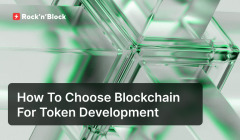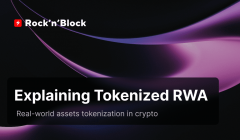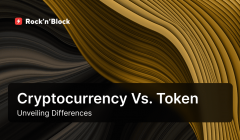6 Token Types in DeFi Development
03 May 2024Welcome to our comprehensive guide on different types of tokens in DeFi token development, where we embark on an insightful journey through the diverse facets of decentralized finance. From understanding the foundations to delving into common standards, and navigating specific types like governance, utility, payment, stablecoins, wrapped and liquidity provider tokens – this guide is your roadmap to the dynamic world of DeFi token development.

Table of Contents:
-
Overview of DeFi Token Development
-
Role of Tokens in DeFi Development
-
Common DeFi Token Standards
-
Governance DeFi Tokens Development
-
Utility DeFi Tokens Development
-
Payment DeFi Tokens Development
-
Stablecoins DeFi Tokens Development
-
Liquidity Provider DeFi Tokens Development
-
Wrapped DeFi Tokens Development
-
Conclusion
Overview of DeFi Token Development
The world of decentralized finance (DeFi) has undergone a significant change with the introduction of DeFi token development. Tokens serve as the foundation of innovative financial ecosystems. DeFi tokens are digital assets that represent ownership or access rights and are built on blockchain. DeFi tokens facilitate decentralized applications (DApps) by enabling value exchange, governance, and other use cases. To understand DeFi token development, it is important to explore the various standards tailored for specific functionalities and blockchain tokens essentials.
Role of Tokens in DeFi Development
DeFi tokens play a crucial role in reshaping traditional financial paradigms in the realm of decentralized finance. At its core, tokens act as the lifeblood of DApps, serving as programmable units of value transfer and representation. Tokens facilitate peer-to-peer transactions, eliminating intermediaries and providing users with direct control over their assets.
In addition to transactions, tokens enable decentralized governance by granting users voting rights and decision-making power in protocol upgrades and changes. Tokens are also essential for motivating user participation through mechanisms such as liquidity provision, yield farming development, and staking. Tokens are essential for value and functionality in the DeFi space. They promote financial innovation and create a financial landscape that is inclusive and accessible, transcending traditional boundaries. To fully grasp the transformative potential and democratizing force of decentralized finance, it is important to understand the diverse roles that tokens play.
Discover the 10 steps to develop a blockchain token in our comprehensive article: How to Create a DeFi Token!
Common DeFi Token Standards
Decentralized finance has emerged as a groundbreaking force in reshaping traditional financial systems, and at the heart of this transformation are various token standards that power decentralized applications and DeFi protocols. In this section, we delve into three common DeFi token standards, each playing a distinct role in the decentralized ecosystem.
ERC-20 Tokens
ERC-20 tokens are based on the Ethereum blockchain and are the backbone of the decentralized world. They represent a wide range of assets, from stablecoins like USDC to governance tokens like UNI. The ERC-20 standard forms the foundation for numerous decentralized applications, enabling seamless integration and interoperability.
ERC-721 Tokens (NFTs)
In contrast to ERC-20, ERC-721 tokens introduce non-fungibility, redefining the concept of uniqueness in the digital realm. Often associated with NFT development, ERC-721 tokens enable the representation of one-of-a-kind items, such as digital art, collectibles, and in-game assets. The uniqueness and ownership of each token are securely recorded on the Ethereum blockchain, opening new horizons for digital ownership and creativity.
BEP-20 Tokens
Built on BNB Chain, BEP-20 tokens mirror the ERC-20 standard. BEP-20 tokens offer a more cost-effective and efficient option, appealing to users and developers looking for faster transaction confirmations and lower fees. PancakeSwap tokens and Venus stablecoins are notable examples utilizing the BEP-20 standard.
👥 Governance DeFi Tokens Development
DeFi thrives on the principles of decentralization and user empowerment, and governance tokens play a pivotal role in putting decision-making authority directly in the hands of the community.
Governance Tokens: Empowering Users
Governance tokens are digital assets that grant holders the power to influence the development and decision-making processes of a decentralized protocol. By holding these tokens, users become stakeholders with voting rights, allowing them to propose and vote on changes to the protocol. This democratic approach to governance aligns with the core principles of decentralization, giving users a direct say in the evolution of the platforms they engage with.
Participating in Decentralized Decision-Making
The essence of user governance lies in active participation. Token holders can propose changes, improvements, or amendments to the protocol, and the broader community votes on these proposals. This inclusive decision-making process extends beyond mere transactions, fostering a sense of community and shared responsibility. Users are not just consumers, they are contributors actively shaping the trajectory of the decentralized ecosystem.
🧩 Utility DeFi Tokens Development
Utility tokens within the realm of DeFi token development are catalysts for innovation, providing a myriad of functionalities that go beyond simple value transfer.
Role of Utility Tokens in DeFi Development
In DeFi token development, utility tokens often act as keys, unlocking doors to decentralized services. They can represent various utilities, including access to premium features, discounted transaction fees, or exclusive benefits within a decentralized application. As blockhain developers explore new avenues in DeFi token development, utility tokens continue to play a crucial role in enhancing user engagement and platform functionality.
Enhancing User Experience with Utility DeFi Tokens Development
The utility tokens development in the DeFi ecosystem goes hand in hand with the goal of creating a seamless and rewarding user experience. Unlike governance tokens that grant voting rights, utility tokens are crafted to enable users to access particular features or services within decentralized applications. Their role is integral to the overall architecture of DeFi protocols, offering a means for users to engage deeply with the platform.
These tokens, carefully integrated into decentralized applications, not only enable users to access specific functionalities but also enhance the overall usability of the platforms. From decentralized exchanges development to lending and borrowing protocols, utility tokens contribute to a more dynamic and engaging user experience.
💸 Payment DeFi Tokens Development
In the broader context of DeFi token development, payment tokens are digital assets designed specifically to facilitate seamless and efficient transactions within DeFi platforms.
Key Features and Functions
Unlike traditional payment methods, these tokens operate on decentralized networks, utilizing blockchain technology and smart contracts development to enhance security, transparency, and accessibility. One primary use case is facilitating peer-to-peer transactions within decentralized applications, allowing users to transfer value seamlessly across borders without the need for traditional financial intermediaries.
Payment DeFi Tokens often extend beyond basic transactional functions: users may utilize these tokens for staking, yield farming, governance participation, or other multifaceted activities within the decentralized ecosystem.
🟠 Stablecoins DeFi Tokens Development
Stablecoins are a crucial element in the dynamic world of DeFi token development. They address the underlying instability associated with many cryptocurrencies by providing stability within decentralized financial ecosystems.
Understanding Stablecoins
Stablecoins are digital assets strategically designed to maintain a stable value. Unlike traditional cryptocurrencies known for their volatility, stablecoins are pegged to the value of external assets, typically fiat currencies like the US Dollar. This stability makes them suitable for everyday transactions and as a reliable store of value within decentralized platforms.
Key Features and Functions
In the realm of DeFi token development, stablecoins are often used as a bridge between the crypto and traditional financial worlds. This feature makes stablecoins an attractive choice for individuals and businesses engaging in decentralized financial activities.
The stability is achieved through methods such as collateralization or algorithmic stabilization. The purpose is to provide users within decentralized ecosystems with a reliable and consistent unit of account, ensuring that the value of the stablecoin remains closely aligned with the designated fiat currency. This stability is particularly valuable in business contexts where a predictable and consistent valuation is essential for financial transactions and planning.
Explore Useful Tools and Platforms for Crypto Token Development!
✨ Liquidity Provider DeFi Tokens Development
In the dynamic world of DeFi token development, liquidity provider tokens emerge as essential tools that power the liquidity infrastructure of decentralized exchanges and protocols.
Understanding LP Tokens
LP tokens represent ownership in a decentralized exchange's liquidity pool, providing a tangible stake for users who contribute their assets. In the broader context of DeFi token development, these tokens serve as a bridge between users and the decentralized exchange, allowing individuals to participate actively in the liquidity provision process.
Users receive a proportional amount of LP tokens, representing their share of the liquidity pool, and may also earn additional governance or utility tokens as rewards for their contribution.
LP tokens are typically issued to users in proportion to their contribution to the liquidity pool, facilitating a fair and transparent distribution mechanism.
Risks and Rewards for Liquidity Providers in DeFi Token Development
Although the potential rewards for liquidity providers can be attractive, it is important to acknowledge the associated risks. Liquidity providers may face challenges such as price impermanence, temporary losses, and smart contract vulnerabilities. However, the rewards, including transaction fees, yield farming incentives, and governance token rewards, often outweigh these risks.
DeFi token development in the context of liquidity provision requires a careful balance between risks and rewards. Implementing mechanisms to mitigate risks and attract liquidity providers is crucial in the DeFi ecosystem. It is important for DeFi developers and liquidity providers to understand the intricacies of these risks and rewards.
🔗 Wrapped DeFi Tokens Development
In the realm of DeFi token development, wrapped tokens emerge as a solution that facilitates cross-chain interoperability, allowing assets from one blockchain to be represented on another.
Cross-Chain Interoperability
Cross-chain interoperability is essential for DeFi token development as it expands the reach of decentralized finance beyond individual blockchain systems. Wrapped tokens serve as bridges between different blockchain networks, enabling interoperability by creating a standardized representation of assets. This allows assets to move seamlessly across various blockchains while retaining their value and characteristics.
Concept of Wrapped Tokens in DeFi Token Development
The concept of wrapped tokens involves pegging assets from one blockchain to create equivalent tokens on another blockchain. This allows users to bring assets from one blockchain (e.g., Bitcoin) and represent them as wrapped tokens on a different blockchain (e.g., Ethereum). The process involves locking the original asset in a smart contract on the native chain, which then mints an equivalent amount of wrapped tokens on the destination chain.
Conclusion
Our exploration of different types of tokens in DeFi token development unveils the intricate layers that shape the decentralized financial landscape. As the DeFi ecosystem continues to evolve, understanding these token types becomes paramount for navigating the ever-expanding possibilities and innovations within this dynamic realm. Whether you're a developer, investor, or enthusiast, this guide serves as a comprehensive resource, providing insights into the multifaceted nature of DeFi token development and its transformative impact on the future of finance.
We ❤️ Development
Follow us on social media to receive the hottest blockchain development updates










